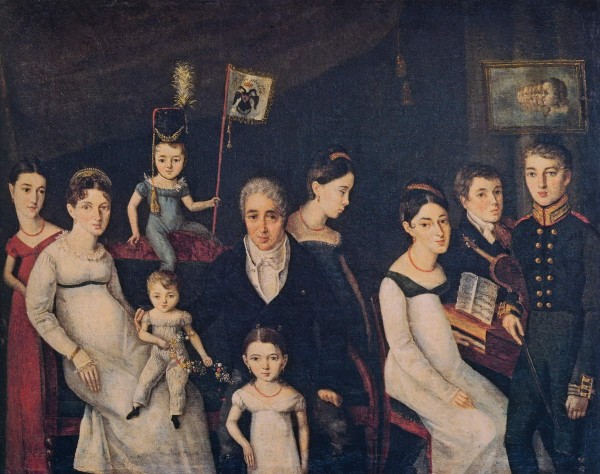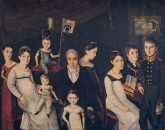Portrait of the Benois Family
Circa 1816
- Period Early 19th century
- CategoryPortrait
- Share
Portrayed here is the founder of the Louis-Jules dynasty (Leontiy: 1770-1822), head waiter at the royal court, who emigrated to Russia from France at the end of the eighteenth century, with his wife Catherine (1777- 1852) and their eight children. There are few such family groups in Russian art. The artist shows surprising imagination in finding a pose and action for each person in accordance with their age. The painting belonged to the Benois family and was permanently kept in the study of Alexander Benois' flat in St Petersburg. According to family legend, the artist's name was Olivie, but no biographical details of him have been found. Play and Passion in Russian Fine Art. St-Petersburg. 1999. P. 34.
My favourite childhood plaything until I was about eight was soldiers. My love for them was like that of some military-mad German princeling.
There were other simple, home-made toys which I liked as well as soldiers, toys with which I became acquainted in my early childhood and also enjoyed in later years. There was, for instance, the bowing gentleman dressed in the morning coat of the 1830s and his lady, who was dressed in a voluminous pink dress and waved her hand. What a quantity of these couples I must have used up over the years! These remarkable mechanical toys were first made in the time of Gogol and were later reproduced by the craftsmen of the Trinity Monastery. In the 1890s, when I started to collect toys systematically, I was delighted to be able to acquire a few surviving models. Another joy of my childhood was toy landscapes, with ducks swimming in a pond to the accompaniment of tinkling string music, bright-coloured birds and animals cut out of papier-mâché (the sheep bleated, the birds sang).
My fondness for the "dwarf-world" must have been stimulated by my father, who also had a passion for miniature objects, and who constructed models for his children as well as for his patrons. In his bookcase, together with a whole village of tiny houses brought from Switzerland in the 1840s, he kept a model of a railway station which he had assembled as a presentation to the Emperor Nicholas I. My brothers told me that he made such models as a preliminary to almost every large building he constructed, spending a great deal of time on meticulous work that was more for his own pleasure than anything else.
I must also mention the castles and little towns made of cork which were sold at the fairs before Easter, in which the cardboard attire of the knights symbolized the death of romanticism. A five-year-old boy, however, had no idea of romanticism as a literary movement. All I knew was that the characters of my favourite fairy tales lived in these castles - Blue Beard, and the Ogre who was changed into a mouse and gobbled up by Puss-in-Boots, and so on. My brother Isha had told me a lot about castles and I had seen some in Papa's albums, so I knew about drawbridges and the machicolated walls with towers at the corners; I even had an idea of the lay-out inside, of the staircases, the halls, the passage. [Alexander Benois, Memoirs] Play and Passion in Russian Fine Art. St-Petersburg. 1999. P. 34-35.

